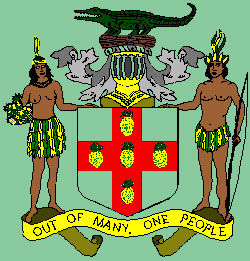
During a recent stay in my island home of Jamaica a local television announcer posed a question about the island’s Coat of Arms. The query was, “Should Jamaica change its Coat of Arms?” One interviewee said, “The Coat of Arms should have black people on it.” The theory was that the island’s Coat of Arms should have images that reflect the island’s African Jamaican majority. Another opinion was, “The Coat of Arms should remain as it is.” A friend from a leading Puerto Rican Taíno organization once stated to me with amazement and pride that Jamaica is the only Caribbean nation that has indigenous people on its Coat of Arms. We often do not pause to think how we are viewed by other nations. Jamaica’s Coat of Arms, originally designed in 1661 by England’s Archbishop of Canterbury, William Sancroft, was later modified for the island’s independence in 1962.
The present Coat of Arms (illustrated above) ingeniously represents different important aspects of the island’s history and composition. Its design elements incorporate the following: (1) An indigenous crocodile atop a log mounted on a British Royal Helmet and Mantling representing Jamaica’s English foundation and its independence from Britain. (2) Superimposed on a cross and shield are five indigenous pineapples (or yayawa in Taíno). This is a symbol of Jamaica’s Christian underpinning. (3) A Taíno couple representing the island’s first inhabitants stands in both a welcoming and protective pose. The woman holds a gift basket of indigenous foods. The man on guard holds a bow. Jamaican Taíno warriors were reputedly skilled bowmen. The bow’s wood was from the sacred genep or jagua (ha-gwa) tree whose white fruit Taíno Indians used to paint their bodies and dye cotton cloth black. (4) The Taíno man and woman stand on Jamaica’s motto, “Out Of Many, One People”. * The national tree, the Blue Mahoe (Hibiscus elatus) only grows naturally in Jamaica and Cuba. Jamaican cabinetmakers use this blue-green durable, beautiful wood for furniture while in Cuba cigar-makers use the inner bark for tying bundles of Havana cigars. * The blue-violet national flower is from the Lignum Vitae (Guiacum officinale) or “wood of life”. Its resin, gum guaiac is a medicine once used for syphilis and later as an ingredient in colon cancer detection. It is an extremely dense wood used to make mortars, malets, gavels, pulleys and police batons. Since it is a self-lubricating wood shipbuilders once used it to make propeller bearings. * The national bird is the swallowtail hummingbird (Trochilus polytmus) or Doctor-bird. This specie only lives in Jamaica.
The Taíno Indians said that this bird was a spirit. The Aztec Indians believed that this territorial fighter was the reincarnated soul of a warrior. In spite of the above, Jamaica has no monument to the Yamaye Taíno whose culture has honed us into a distinctive Caribbean people. No Yamaye heroes in Jamaica Jamaica (n). An English word based on the Taíno name for the island. First recorded phonetically in Spanish as Xaymaca (hi-mah-kah). Yamaye (n). The Taíno people of Jamaica. Why do the Jamaican Taíno Indians deserve a place in New Kingston’s Heroes Park? Consider the following: (1) They were the island’s first heroes. According to Clinton Black in his Story of Jamaica, when Columbus approached their shore on the North Coast in 1494, “sixty or seventy [Taíno] canoes laden with angry shouting warriors” attempted to drive him away. Many of them paid with their lives when the Admiral retaliated with the deadly force of crossbow fire and Spanish war dogs. As the island’s first diplomats, “the following day six Indians brought peace offerings of cassava, fruit and fish, and for the rest of the Admiral’s stay supplied him and his men with provisions.” Taíno of Bahia de Vaca (Cow Bay of Portland Bight) accommodated Columbus. According to Clinton Black “Columbus found the most intelligent and civilized aborigines of all he met in the Antilles.” Columbus’ description of the local cacique and his emissaries and the design elements in their regalia is reminiscent of the high cultures of the Yucatan’s Maya and Aztec civilizations. “One of the cacique’s men who stood alone in the prow of the canoe, wore a cloak of red feathers shaped like a coat of arms, a great crown of feathers and carried a white banner. Most of the other men had their faces painted in various colours, wore feather helmets and large, round forehead ornaments. Two men, painted differently from the rest, carried trumpets made of a very black wood covered with carvings of birds and other designs.” (2) Under European slavery in the Caribbean, enslaved Taíno suffered a worse fate than imported Africans. (3) As the first maroons (cimarrón), the Taíno paved the way for Jamaican heroes Nanny and Cudjoe by accepting runaway Africans into their mountainous refuges. Today’s lucrative world-famous jerk cuisine and spices are the byproducts of this cross-cultural exchange. Like Bob Marley who made reggae music, the Rastafarian religion and dreadlocks world famous, the Yamaye Taíno deserve commemorative statuary monuments.










